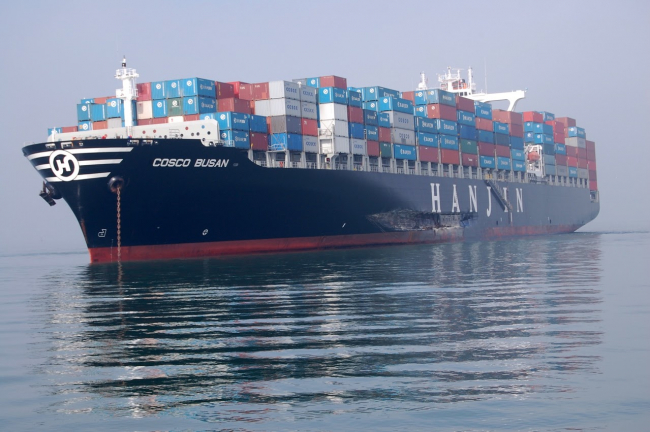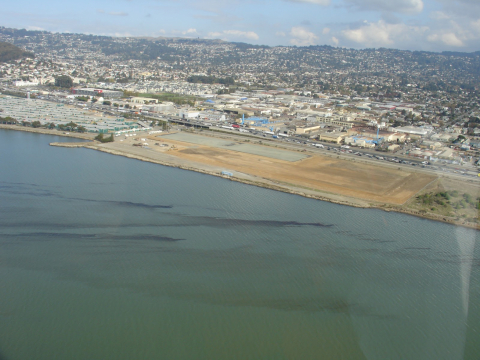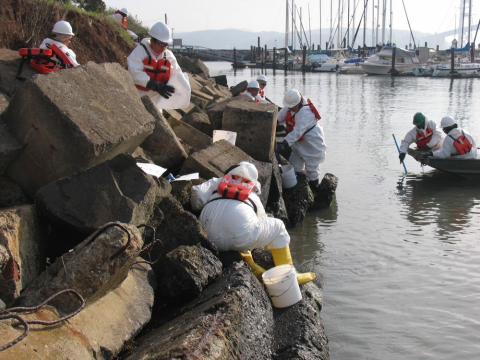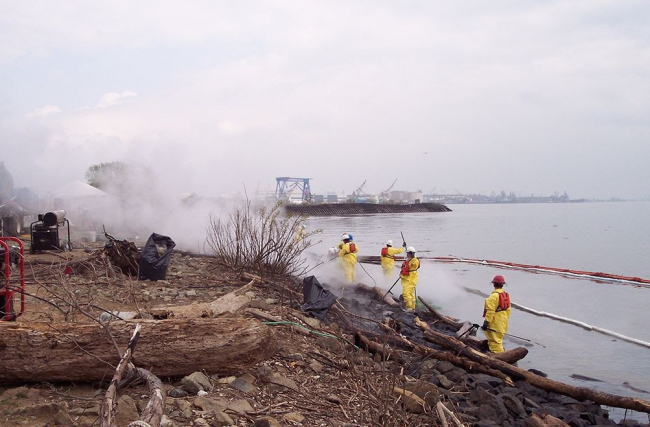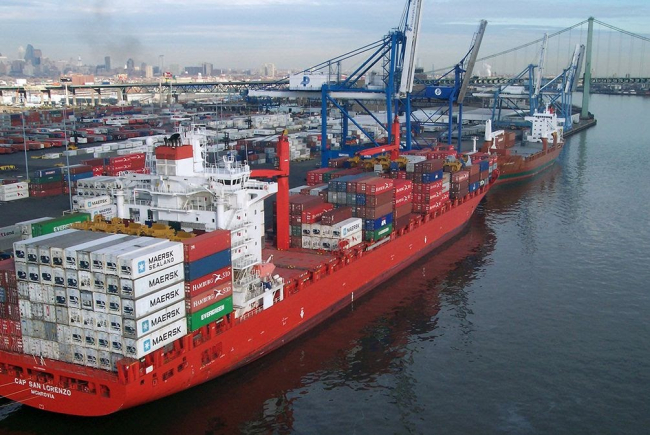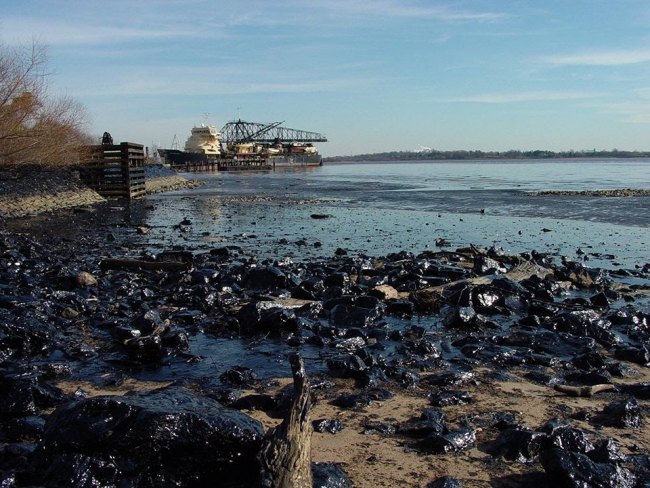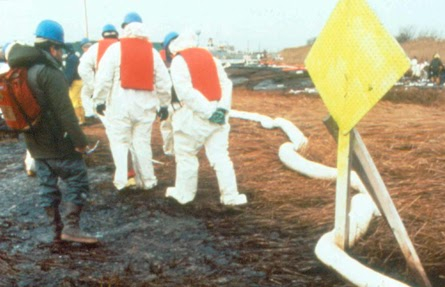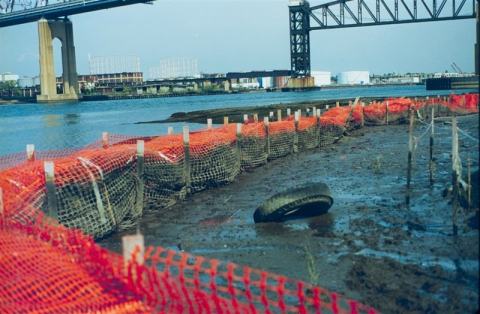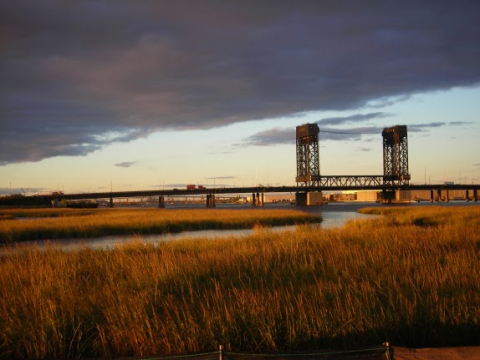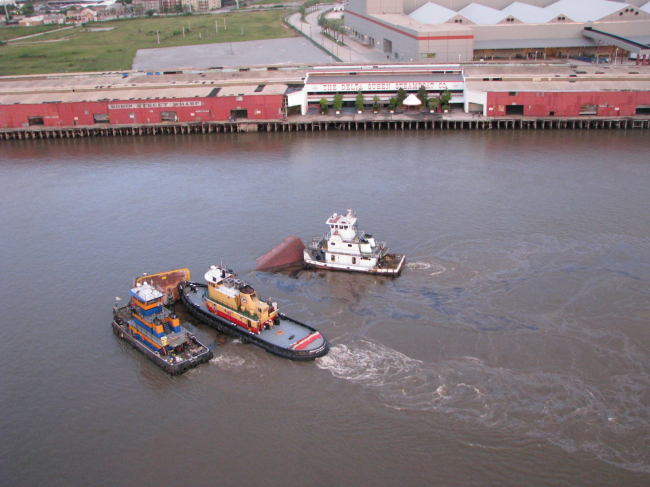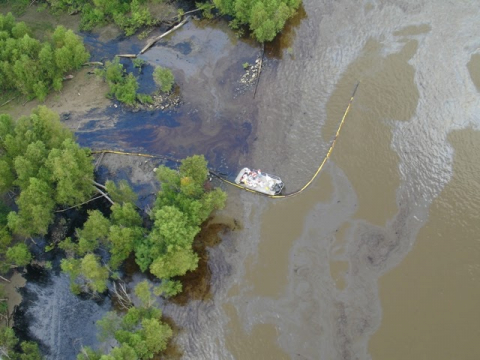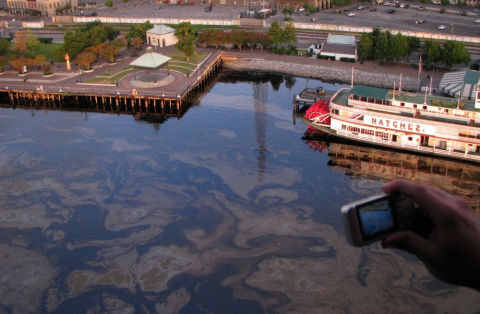This week, we’re taking a look at the different types of urban industrial pollution, how NOAA responds to pollution events and aids in the recovery of natural resources lost due to pollution, and what you can do to help keep pollution out of your waterway. Stay tuned as we explore these topics through a series of blogs.
What’s different about spills in urban environments? When we hear or read about an oil spill, we often envision thick oil sullying a wilderness or open ocean environment—but most spills occur in more urban areas, where oil terminals, refineries, ports and marinas, or rail facilities are situated.
Although spills in industrialized centers don’t support the dramatic abundance of wildlife that a wilderness area might, there are still critical resources—including fish, birds, and other wildlife, and resources for recreational or human use—that need to be protected for these large population centers. In addition, urban centers concentrate more people who might be directly affected by a spill, such as through visual impacts when oil affects parks or beaches; noxious odors that can be just a nuisance or an actual safety concern; threats to their real estate property, boats, etc.; and even feeling a need to help or volunteer with the response.
Additionally, urban spills often carry a more significant impact on commerce. In a port city, the harbor could close, and oil booms, barriers, skimmers, and other equipment could affect vessel traffic. Water intakes for various purposes (e.g., industrial or civic uses, or even the city’s aquarium) could be affected.
Evaluating impacts in urban spill incidents can be more challenging. If a baseline of chronic and non-point pollution is lacking, it can make it more difficult to assess impacts from the spill event. In some places, there may still be sensitive biology, such as orcas in Pacific Northwest waters, or species of salmon migrating through urban harbors, such as in Seattle and Portland, Oregon. Other sensitive biological resources are even less obvious.
NOAA works closely with the U.S. Coast Guard, states, responsible parties, and other partners to quickly respond to these spills to minimize their impact and help ecosystems and communities recover more quickly. NOAA provides expert scientific support, conducts overflights, identifies resources at risk, produces trajectories that estimate where the oil will go (needed to place booms and place boats, equipment and personnel), leads shoreline assessments, and suggests the most cost-effective actions to contain and minimize the impact.
Below, check out some oil spills that occurred in industrial and urban waterways and the types of impacts that they created, and the efforts of NOAA and partners to protect and restore injured resources.
M/V Cosco Busan—San Francisco, 2007
When the container ship Cosco Busan struck one of the towers of the San Francisco-Oakland Bay Bridge on Nov. 7, 2007, the impact tore a large gash in the hull of the vessel. The 53,000 gallons of fuel oil that spilled seemed relatively small compared with the millions of gallons from large, highly damaging spills—and in a highly urban environment. Yet that incident had a major impact on the Bay Area, on both the habitat and the public outlook. The oil quickly spread to other parts of the Bay and the outer coast (north and south of the Golden Gate Bridge), washing ashore along many miles of sensitive coastline. NOAA and co-trustees documented that the spill caused significant impacts to fish, wildlife, habitat, and human recreational uses. Miles of beaches were closed; fishing and crabbing were suspended. An estimated one million recreation days were lost. Bunker fuel proved especially toxic to sea life. Fish and birds were highly impacted, with more than 6,800 dead birds documented, including many marbled murrelets, a threatened species.
Learn more about this spill, its impacts, and how the site is being restored:
- NOAA’s Damage Assessment, Remediation, and Restoration (DARRP) Program.
- OR&R Blog series at the 10-year anniversary of the Cosco Busan spill.
- Photo Collection: Cosco Busan spill.
M/T Athos I—Delaware River, New Jersey, 2004
Just outside of Philadelphia on Nov. 26, 2004, the oil tanker Athos I unknowingly ripped its hull on an 18,000 pound anchor hidden on the river bottom. The accident released more than 263,000 gallons of heavy oil into an industrialized stretch of the Delaware River and severely affected the region’s economy. Commercial traffic on this active shipping route was halted for more than a week, delaying over two hundred vessels. Claims paid to affected businesses topped $162.6 million. The nearby Salem Nuclear Power Plant shut down two reactors for 11 days, at a cost of $33.1 million, because the heavy oil was near neutral buoyancy, sank to the river bottom, and had the potential of clogging the power plant’s critical cooling water intake system.
During the brutal winter conditions of this response, the OR&R team conducted aerial surveys of the oil, helped identify resources at risk, produced oil trajectories and other information used to manage the power plant shutdown, and supported the inspection and cleanup of hundreds of miles of shoreline in three states. The cleanup took a full year until all the shorelines were signed off as clean.
In addition to the economic effects of this spill, NOAA and co-trustee partners determined that the Athos incident also caused serious environmental effects. Almost 12,000 birds died as a result of the spill. Spilled oil washed up on 280 miles of shoreline, which included sensitive marshes, beaches, and mudflats. In the way of human-use impacts, the spill affected nearly 42,000 recreational boating and fishing trips along the river.
Learn more about this spill, its impacts, and how the site is being restored:
- NOAA’s Damage Assessment, Remediation, and Restoration (DARRP) Program.
- Department of Commerce Blog: Remembering a Little Known Oil Spill with Out-Sized Impacts.
- ORR Blog: Before Breaking Ground for Restoration, Digging for Signs of the Past. November 2014.
- OR&R Blog: Bringing Urban Waterfronts Back to Life: Philadelphia Edition. May 2012.
- OR&R Blog: Oil Spills and the Holidays: Black Friday Takes a New Meaning. November 2011.
- Photo Collection: Athos I spill.
- Infographic: 10 Years After Delaware River Oil Spill.
Exxon Bayway facility—Linden, New Jersey, 1990
On Jan. 1-2, 1990, no. 2 fuel oil spilled from the Exxon Bayway facility’s underwater pipeline in Linden, New Jersey. Approximately 567,000 gallons were released directly into the Arthur Kill, a saltwater channel between New Jersey and Staten Island. OR&R joined the U.S. Coast Guard on-scene, responding to the spill within hours. The OR&R team helped to identify resources at risk in the more than two thousand acres of fish and wildlife habitats that were blanketed with oil, advised on protective booming, recommended oil recovery methods, helped analyze the chemistry of the oil involved, and monitored cleanup progress. NOAA and partners documented that the oiling smothered fish, crabs, and clams, and caused massive losses of salt marsh cordgrass (Spartina alterniflora) in some wetlands. The oil also directly killed an estimated 700 waterbirds.
Learn more about this spill, its impacts, and how the site is being restored:
Fuel Barge DM932—New Orleans, 2008
On July 23, 2008, the chemical tanker Tintomara collided with fuel barge DM932 on the Mississippi River, near downtown New Orleans. The Tintomara suffered minor damage, but the DM932 barge split into two sections, spilling 270,000 gallons of fuel oil. Within hours of the spill, spill specialists from OR&R were on-scene, providing support to restore shipping commerce and minimize environmental damage to the Mississippi River, the Mississippi Delta, and the Gulf of Mexico. The OR&R team provided oil trajectories based on local weather forecasts and river flow data; conducted aerial overflights to track the location and degree of oiling; advised on oil containment, and assessed natural resource damages.
Studies conducted by NOAA and co-trustees found that in addition to harming wildlife, wetlands, and other coastal habitats, the incident resulted in significant economic disruption including extensive waterway closures, closure of municipal and industrial water intakes, and interference with critical channel dredging activities.
The rapid response from NOAA and hundreds of other federal, state, and private responders helped contain and clean up the spill, helping to protect the birds, reptiles, and amphibians that are abundant in the river delta, as well as the many human-use resources in this region.
Learn more about this spill, its impacts, and how the site is being restored:
- NOAA’s Damage Assessment, Remediation, and Restoration (DARRP) Program.
- Video chronicling OR&R's efforts during the spill, the impacts to the Mississippi River, and the continuing restoration efforts: De-Oiling the Delta: Video of the DM932 Oil Spill Response.
- Ocean Today video: Oil in the Ocean.
So it’s important to remember: all spills have potential to cause harm. Even in urban/industrial waterways, there are important resources that can be impacted and require intense response, assessment, and eventual restoration.

